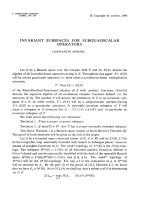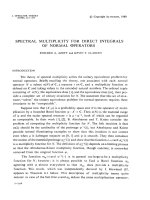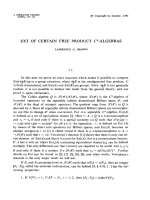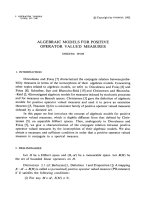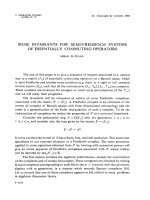Báo cáo toán hoc:" Anti-Ramsey numbers for graphs with independent cycles Zemin Jin" ppt
Bạn đang xem bản rút gọn của tài liệu. Xem và tải ngay bản đầy đủ của tài liệu tại đây (128.23 KB, 8 trang )
Anti-Ramsey numbers for graphs with
independent cycles
Zemin Jin
Department of Mathematics, Zhejiang Normal University
Jinhua 321004, P.R. China
Xueliang Li
Center for Combinatorics and LPMC-TJKLC, Nankai University
Tianjin 300071, P.R. China
Submitted: Dec 22, 2008; Accepted: Jul 2, 2009; Published: Jul 9, 2009
Mathematics Subj ect C lassifications: 05C15, 05C38, 05C55
Abstract
An edge-colored graph is called rainbow if all the colors on its edges are distinct.
Let G be a family of graphs. The anti-Ramsey number AR(n, G) for G, introduced
by E rd˝os et al., is the maximum number of colors in an edge coloring of K
n
that
has no rainbow copy of any graph in G. In this paper, we determine the anti-
Ramsey number AR(n, Ω
2
), where Ω
2
denotes the family of graphs that contain
two independent cycles.
1 Introduction
An edge-colored graph is called rai nbow if any of its two edges have distinct colors. Let G
be a family of graphs. The anti-Ramsey number AR(n, G) for G is the maximum number
of color s in an edge coloring of K
n
that has no rainbow copy of any graph in G. The
Tur´an number ex(n, G) is the maximum number of edges of a simple graph without a
copy of any graph in G. Clearly, by ta king one edge of each color in an edge coloring of
K
n
, one ca n show that AR(n, G) ≤ ex(n, G). When G consists of a single graph H, we
write AR(m, H) and ex(n, H) for AR(m, {H}) and ex(n, {H}), respectively.
Anti-Ramsey numbers were introduced by Erd˝os et al. in [5], and showed to be
connected not so much to Ramsey theory than to Tur´an numbers. In particular, it was
proved that AR (n, H) − ex(n, H ) = o(n
2
), where H = {H − e : e ∈ E(H)}. By
the electronic journal of combinatorics 16 (2009), #R85 1
the asymptotic of Tur´an numbers, we have AR(n, H)/
n
2
→ 1 − ( 1 /d) as n → ∞,
where d + 1 = min{χ(H − e) : e ∈ E(H)} . So the anti-Ramsey number AR(n, H) is
determined asymptotically for gr aphs H with min{χ(H − e) : e ∈ E(H)} ≥ 3. The case
min{χ(H − e) : e ∈ E(H)} = 2 remains harder.
The anti-Ramsey numbers for some special gra ph classes have been determined. As
conjectured by Erd˝os et al. [5], the anti-Ramsey number for cycles, AR(n, C
k
), was
determined for k ≤ 6 in [1 , 5, 8], and later completely solved in [11]. The anti-Ramsey
number for paths, AR(n, P
k+1
), was determined in [13]. Independently, the authors of
[10] and [12] considered the anti-Ramsey number for complete graphs. The anti-Ramsey
numbers for other graph classes have been studied, including small bipartite graphs [2 ],
stars [6], subdivided g raphs [7], trees of o rder k [9], and matchings [12]. The bipartite
analogue of the anti- Ramsey number was studied for even cycles [3] and for stars [6].
Denote by Ω
k
the family of (multi)graphs that contain k vertex disj oint cycles. Vertex
disjoint cycles are said to be independent cycles. The family of (multi)graphs not belonging
to Ω
k
is denoted by Ω
k
. Clearly, Ω
1
is just the family of fo rests. In this paper, we consider
the anti-Ramsey numbers for the family Ω
k
. It was proved in [5] that AR(n, C
3
) = n − 1.
In fact, from the appendix of [5], we have AR(n, Ω
1
) = n−1. Using the extremal structures
theorem for graphs in Ω
2
[4], we determine the a nti-Ramsey number AR(n, Ω
2
) for n ≥ 6.
The bounds of AR(n, Ω
k
), k ≥ 3, are discussed.
Let G be a graph and c be an edge coloring of G. A representing subgra ph of c is a
spanning subgraph of G, such that any two edges of which have distinct colors and every
color of G is in the subgraph. For an edge e ∈ E(G), denote by c(e) the color assigned to
the edge e.
2 Extremal structures theorem for graphs in Ω
2
First, we present extremal structures for the gr aphs which do not contain two independent
cycles.
Theorem 2.1 [4] Let G be a multigraph without two independent cycles. Suppose that
δ(G) ≥ 3 and there is no vertex contained in all the cycles of G. The n one of the following
six assertions holds (see Figure 1).
(1) G h as three vertices and multiple edges joini ng every pair of the vertices.
(2) G is a K
4
in which one of the triangles may have multiple edges.
(3) G
∼
=
K
5
.
(4) G is K
−
5
such that some of the edges not adjacent to the missing edge may be multiple
edges.
(5) G is a wheel whose spokes may be multiple edges.
(6) G is obtained from K
3,p
by adding edges or multiple edges joining vertices in the first
class.
the electronic journal of combinatorics 16 (2009), #R85 2
a
G
b
G
e
G
c
G
d
G
f
G
Figure 1: The graphs G
a
, G
b
, G
c
, G
d
, G
e
and G
f
In general, we have the following result.
Theorem 2.2 [4] A multigraph G does not contain two independent cycles if and only
if either it contains a verte x x
0
such that G − x
0
is a forest, or it can be ob tain ed from
a subdivision G
0
of a graph listed in Figure 1 by adding a forest and at most one edge
joining each tree of the forest to G
0
.
More precisely, from the theorem above, we have the following lemmas.
Lemma 2.3 Let G be a simple graph of order n and size m. If G contains a vertex x
0
such that G − x
0
is a forest, then m ≤ 2n − 3.
Lemma 2.4 Let G be a simple graph of order n and size m. Suppose that G can be
obtained from a subdivision G
0
of a graph listed in Figure 1 by adding a forest and at
most one edge joining each tree of the f orest to G
0
. Then
the electronic journal of combinatorics 16 (2009), #R85 3
(1). if G
0
is a subdivision of G
a
, m ≤ 2n − 3.
(2). if G
0
is a subdivision of G
b
, m ≤ 2n − 2.
(3). if G
0
is a subdivision of G
c
, m ≤ n + 5.
(4). if G
0
is a subdivision of G
d
, m ≤ 2n − 1. Furthermore, the equality holds if
and only if G contains fi v e distinct vertices u , v, w, x, y such that G[{u, v, w, x, y}] = K
−
5
,
uv /∈ E(G), and each vertex z ∈ V (G) − {u, v, w, x, y} is adjacent to just two vertices of
{w, x, y}.
(5). if G
0
is a subdivision of G
e
, m ≤ 2n − 2.
(6). if G
0
is a subdivision of G
f
, m ≤ 2n+p−3. Furthermore, when p = 3, the equality
holds if and only if G can be obtained from K
3,3
by adding two edges joining vertices in
the fi rst class, a nd each vertex not in K
3,3
is adjacent to just two ve rtices of the first cla s s.
3 Anti-Ramsey numbers for Ω
2
Let G be a graph of order n. An edge coloring c of K
n
is induced by G if c assigns distinct
colors to the edges of G a nd assigns one additional color to all the edges of G. Clearly,
an edge coloring of K
n
induced by G has |E(G)| + 1 colors (unless G = K
n
). Given two
vertex disjoint graphs G and H, denote by G + H the graph obtained from G ∪ H by
joining every vertex of G to all the vertices o f H. We have the following result.
Theorem 3.1 For any n ≥ 7, AR(n, Ω
2
) = 2n − 2.
Proof. Lower bound
Let G
∼
=
K
2
+K
n−2
. Suppose c is an edge coloring of K
n
induced by G. For any graph
H ∈ Ω
2
of order at most n, any copy of H in K
n
must contain at least two edges not in
G. Then the edge coloring c of K
n
has no rainbow graph in Ω
2
. This immediately yields
the lower bound AR(n, Ω
2
) ≥ 2n − 2.
Upper bound
In order to prove the upper bound, here we only need to show that any (2n − 1)- edge-
coloring of K
n
always contains a rainbow subgraph belonging to the family Ω
2
. Supp ose
that there is a (2n−1)-edge-coloring c of K
n
which does not contain any rainbow subgraph
belong ing to the family Ω
2
. Let G be a representing graph of c . Then G does not contain
two independent cycles. From Theorem 2.2 and L emma 2.3, we have that G can be
obtained from a subdivision G
0
of a graph listed in Figure 1 by adding a forest and at
most one edge joining each tree of the forest to G
0
. Since |E( G )| = 2n − 1, from Lemma
2.4 we have that G
0
is a subdivision of G
d
or G
f
. To complete the proof, we distinguish
the following cases.
the electronic journal of combinatorics 16 (2009), #R85 4
Case 1. G
0
is a subdivision of G
d
.
Since |E(G)| = 2n − 1, from Lemma 2.4, we may assume that G contains five distinct
vertices u, v, w, x, y such that G[{u, v, w, x, y}] = K
−
5
and uv /∈ E(G), and take a vertex
z ∈ V (G) − {u, v, w, x, y} with N(z) = {x, y}. Further more, since n ≥ 7, from Lemma
2.4, there is a vertex s ∈ V (G)−{u, v, w, x, y, z} a djacent to just two vertices of {w, x, y}.
Now, considering t he possible neighborhood of the vertex s, we distinguish the follow-
ing subcases.
Subcase 1.1 The vertex s is not adjacent to both x and y.
By the symmetry of x and y, without loss of generality, we assume that s is adjacent
to just the vertices x and w.
Since the cycle xyzx is rainbow, we have
c(uv) ∈ {c(uw ) , c(wv), c(xy), c(yz), c(xz)},
otherwise the union of the cycles uvwu and xyzx is a rainbow graph belonging to the
family Ω
2
. So the cycle uvyu is rainbow, and the union o f the cycles uvyu and xswx is a
rainbow graph belonging to the family Ω
2
. A contradiction.
Subcase 1.2 The vertex s is adjacent to both x and y.
Since the cycle ywvy is rainbow, we have
c(sz) ∈ {c(sx), c(xz), c(wv), c(yw), c(yv)},
otherwise the union of the cycles yw vy and xszx is a ra inbow graph belonging to the
family Ω
2
.
Since the cycle xwux is rainbow, we have
c(sz) ∈ {c(sy), c(yz), c(wu), c(ux), c(wx)},
otherwise the union of the cycles xwux and ysz y is a rainbow graph belonging to the family
Ω
2
, a contradiction, since the two sets {c(sx), c(xz), c(wv), c(yw), c(yv)} and {c(sy), c(yz),
c(wu), c(ux), c(wx)} have no common elements.
Case 2. G
0
is a subdivision of G
f
.
From Lemma 2.4, p ≥ 2. If p = 2, since |E(G)| = 2n − 1, G
0
must be a subdivision
of G
d
, and we only need to go back to the previous case. So we may assume that p ≥ 3.
Denote by u, v, w all the vertices in the first class of G
f
. Note that for each edge x
1
x
2
of G
f
, it may be subdivided to a path connecting the vertices x
1
and x
2
in G. For
convenience, we still use the notation x
1
x
2
to denote the corresponding path in G.
Suppose p ≥ 4. Let x, y, z, s be four distinct vertices in the second class of G
f
. If
c(zs) /∈ {c(wz), c(ws), c(ux), c(uy), c(vx), c(vy)}, then the union o f the cycles wzsw and
uxvyu is a rainbow graph belonging to the family Ω
2
. So c(zs) ∈ {c(wz) , c(ws), c(ux),
the electronic journal of combinatorics 16 (2009), #R85 5
c(uy), c(vx), c(vy)}. Then either the union of the cycles uzsu and vxwyv or the union of
the cycles vzsv and uxwyu is a rainbow graph belonging to the family Ω
2
.
So, let p = 3 and denote by x, y, z all the vertices in the second class of G
f
. Since
|E(G)| = 2n − 1, from Lemma 2.4, there are at least two edges joining vertices of u, v and
w. Without loss o f generality, assume that uv, vw ∈ E(G). Since n ≥ 7, from Lemma
2.4, there is a vertex s ∈ V (G) − {x, y, z, u, v, w} that is adjacent to just two vertices of
{u, v, w}.
If c(yz) /∈ {c(wz), c(wy), c(u x), c(uv), c(vx)}, then the union of the cycles w yzw and
uxvu is a rainbow graph belonging to the family Ω
2
. So we have c(yz) ∈ {c(wz), c(wy),
c(ux), c(uv), c(vx)}. Then the cycle yzuy is rainbow. Since the cycle xwvx is rainbow, we
have c(yz) = c(xv), otherwise the union of the cycles yzuy and xwvx is a rainbow graph
belong ing to the family Ω
2
. By the analog analysis, we have c(xy) = c(vz).
Now, considering the possible neighborhood of the vertex s, we only need to distinguish
the following subcases.
Subcase 2.1 The vertex s is adjacent to just the vertices v and w.
Since c(yz) = c(xv), we have that the union of the cycles yzuy and swvs is a rainbow
graph belonging t o the family Ω
2
, a contradiction.
Subcase 2.2 The vertex s is adjacent to just the vertices u and w.
Since c(yz) = c(xv), we have
c(sv) ∈ {c(ws), c( wv), c(uy), c(uz), c(yz)},
otherwise the union of the cycles swvs and yzuy is a rainbow graph belonging to the
family Ω
2
. By the analog analysis, from c(xy) = c(vz), we have
c(sv) ∈ {c(us), c(uv), c(xy), c(xw), c(yw)},
a contradiction, since the two sets {c(ws), c(wv), c(uy), c(uz), c(yz)} and {c(us), c(uv),
c(xy), c (xw), c(yw)} have no common elements.
This completes the proof.
4 The value of AR(6, Ω
2
)
In this section, we present an 11- edge-coloring of K
6
which does not contain any graphs in
Ω
2
. Let V (K
6
) = {u, v, w, x, y, z}. Define an 11-edge-coloring φ of K
6
as follows. Let G =
K
6
−uv −uz −vz −wz. Clearly, the size of G is just 11. Color the edges of G with distinct
colors. Then color the edges uv and wz with the same color in {φ(xy), φ(u w), φ(wv), color
the edge uz with the color φ(wv), and color the edge vz with the color φ(uw). It is easy
to verify that the edge coloring φ of K
6
does not cont ain any graph in the family Ω
2
.
This implies the lower bound AR(6, Ω
2
) ≥ 11. In fact, using the same analysis as in the
the electronic journal of combinatorics 16 (2009), #R85 6
previous section, we can show that any 12-edge-coloring of K
6
contains a rainbow graph
belong ing to the family Ω
2
. To complete the section, we have the f ollowing result.
Theorem 4.1 AR(6, Ω
2
) = 11.
5 Bounds of anti-Ramsey numbers for Ω
k
Unlike graphs in the family Ω
2
, we have no more information about graphs in the family
Ω
k
for k ≥ 3. So we cannot treat the family Ω
k
(k ≥ 3) as we did for the case Ω
2
.
Fortunately, the bound of ex(n, Ω
k
) presents an upper bound of AR(n, Ω
k
) for k ≥ 3. Let
f(n, k) = (2k − 1)(n − k) and
g(n, k) =
f(n, k) + (24k − n)(k − 1), if n ≤ 24k;
f(n, k), if n ≥ 24k.
Lemma 5.1 [4] Every graph G of order n ≥ 3k, k ≥ 2, and size at least g(n, k) contains
k independent cycles except whe n n ≥ 24k and G
∼
=
K
2k−1
+ K
n−2k+1
.
This easily yields AR(n, Ω
k
) < g(n, k). Let G
∼
=
K
2k−2
+ K
n−2k+2
. Clearly, the edge
coloring of K
n
induced by G has no rainbow graph in Ω
k
. Then we have the following
result.
Theorem 5.2 For any i nteger n and k, n ≥ 3k, k ≥ 2,
2k − 2
2
+ (2k − 2)(n − 2k + 2) + 1 ≤ AR(n, Ω
k
) ≤ g(n, k) − 1.
When n is large enough, i.e., n ≥ 24k, the gap between the upper bound a nd the lower
bound is just n − 2k − 1. Fro m Theorem 3.1 , we know the lef t equality holds for n ≥ 7
and k = 2. In fact, though we cannot prove it, we feel that the value of AR(n, Ω
k
) would
be very near to the lower bound rather than the upper bound.
Conjecture 5.3 For any integer n and k, n ≥ 3k, k ≥ 2,
AR(n, Ω
k
) =
2k − 2
2
+ (2k − 2)(n − 2k + 2) + 1.
Acknowledgement Z. Jin wa s supp orted by the Na tional Natural Science Foundation
of China (10701065) and the Natural Science Foundation of Department of Education of
Zhejiang Province of China (200 704 41) . X. Li was supported by the Nat io nal Natural
Science Foundation of China (10671102), PCSIRT, and the “973” program.
the electronic journal of combinatorics 16 (2009), #R85 7
References
[1] N. Alon, On a conjecture of Erd˝os, Simonovits and S´os concerning anti-Ramsey
theorems, J. Graph Theory 1 (1983), 91-94.
[2] M. Axenovich and T. Jiang, Anti-Ramse y numbers for small complete bipartite
graphs, Ars Combin. 73 (2004), 311-318.
[3] M. Axenovich, T. Jiang, and A. K¨undgen, Bipartite anti-Ramsey numbers o f cycles,
J. Graph Theory 47 (2004), 9-28.
[4] B. Bollob´as, Extremal Graph Theory, Academic Press, New York, 1978.
[5] P. Erd˝os, M. Simonovits, and V.T. S´os, Anti-Ramsey theorems, Colloq. Math. Soc.
Janos Bolyai. Vol.10, Infinite and Finite Sets, Keszthely (Hungary), 1973, pp. 657-
665.
[6] T. Jiang, Edge-colorings with no la rge polychromatic stars, Graphs Combin. 18
(2002), 303-308.
[7] T. Jiang, Anti-Ramsey numbers of subdivided graphs, J. Combin. Theory, Ser.B, 85
(2002), 361-366.
[8] T. Jiang and D.B. West, On the Erd˝os-Si monov i ts-S ´os conjecture on the anti-Ramsey
number of a cycle, Combin. Probab. Comput. 12 (2003), 585–598.
[9] T. Jiang and D.B. West, Edge- colorings of complete g raphs that avoid polychromatic
trees, Discrete Math. 274 (2004), 137-145.
[10] J.J. Montellano-Ballesteros and V. Neumann-Lara, An anti-Ramsey theorem, Com-
binatorica 22 (2002), 445-449.
[11] J.J. Montellano-Ballesteros and V. Neumann-Lara, An anti-Ramsey theorem on cy-
cles, Graphs Combin. 21 (2005), 343-354.
[12] I. Schiermeyer, Rainbow numbers for m atching s and co mplete graphs, Discrete Math.
286 (2004), 157-162.
[13] M. Simonovits and V.T. S´os, On restricting colorings of K
n
, Combinatorica 4 (1984),
101-110.
the electronic journal of combinatorics 16 (2009), #R85 8

